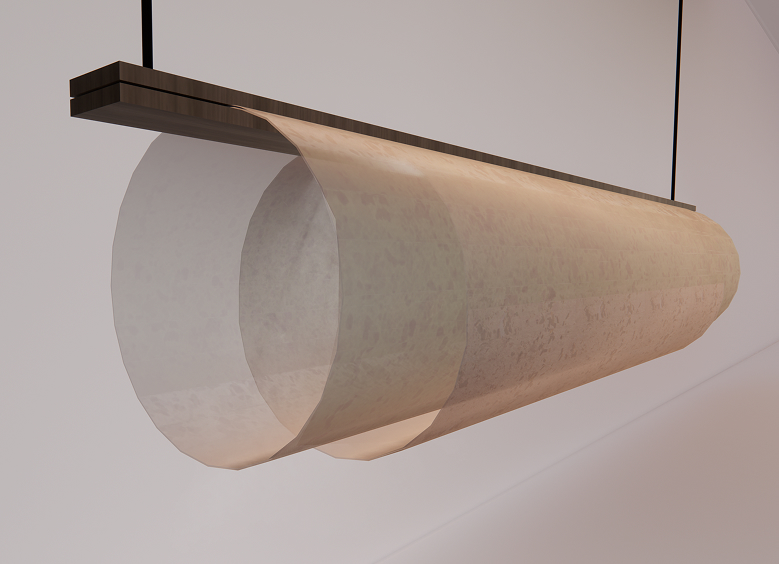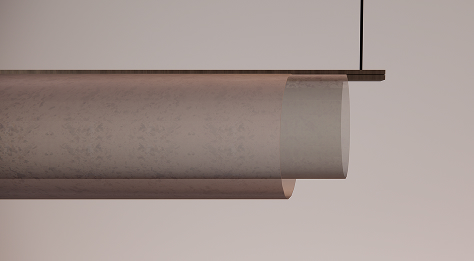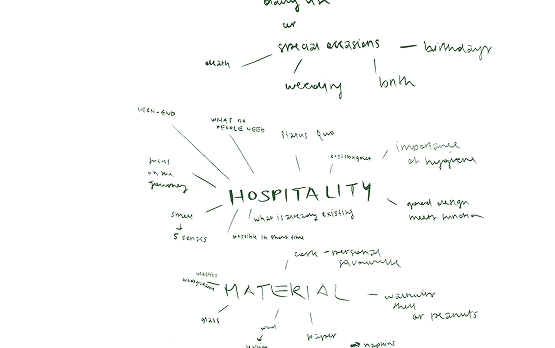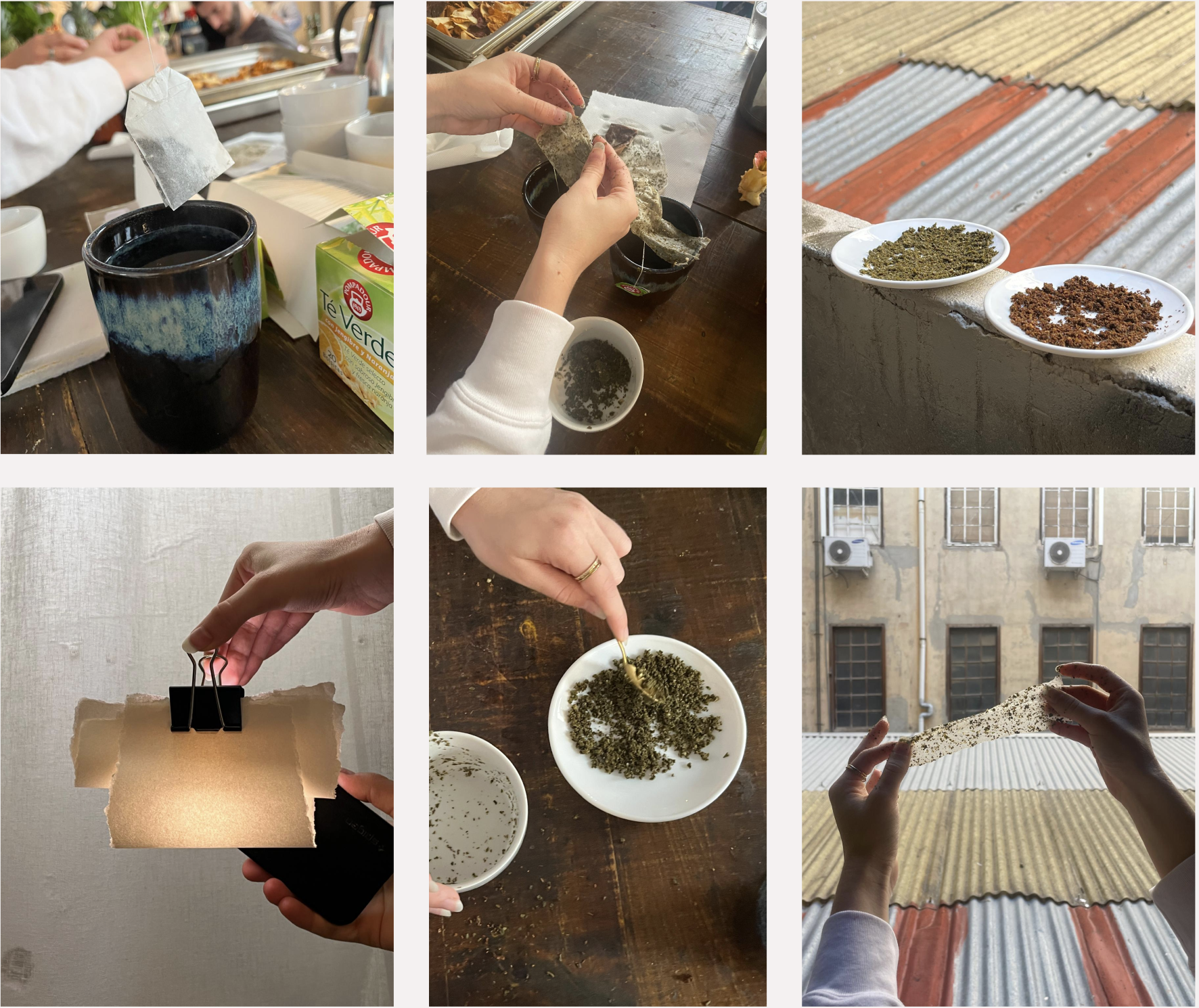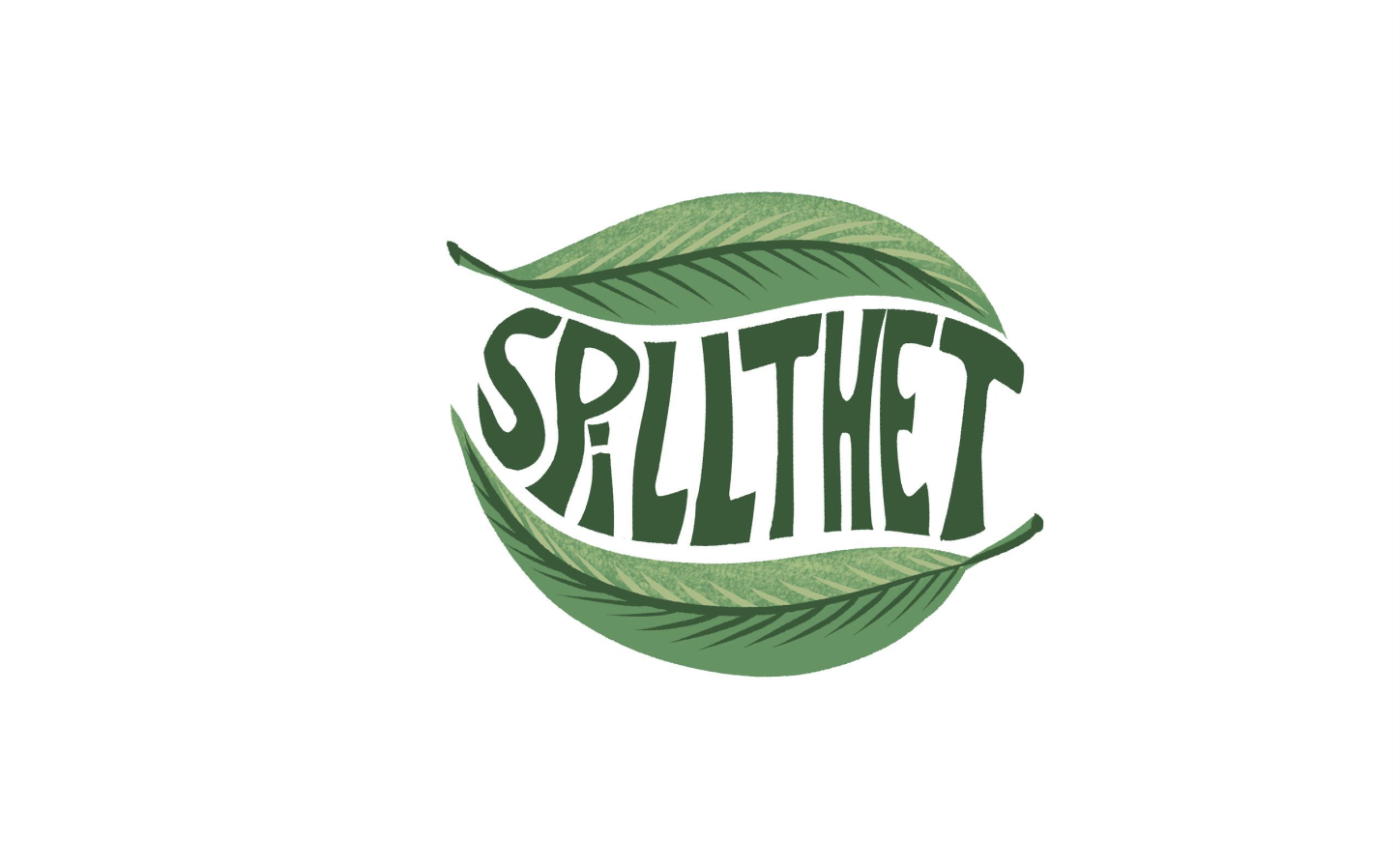SPILL THE T
CONCEPT
Transforming the ritual of tea into a circular design cycle.
Our project explores how the hospitality industry can become a space of material innovation. We chose to collaborate specifically with teahouses, places known for mindfulness and ritual, and to focus on one overlooked by-product — tea waste, the spent tea leaves left after brewing.
Across Europe, teahouses are gaining new cultural importance as slow, reflective spaces. Every cup of tea, however, leaves behind organic residues that are usually thrown away. Considering the millions of cups brewed each day, this adds up to a vast and underused resource.
We set out to transform this waste into new value by developing a biomaterial made from used tea leaves and their teabags itself. The result is a fully biodegradable material, which we shaped into lampshades and interior objects designed specifically for teahouse environments.
These objects not only fit seamlessly into the calm, natural atmosphere of teahouses — they also embody a closed material loop. After their use, they can be composted at home, enriching the soil from which new tea can grow.
Through this process, “Spill The T” turns everyday hospitality waste into a symbol of circularity, regeneration, and design mindfulness.
TEAM
I believe that blending science with design can create the solutions our world needs most. By developing novel materials and technologies and sharing knowledge openly, we can empower more people to create a positive impact.
Graduating from the Textile Design MA program at MOME, Nora now works as a research intern at the MOME Innovation Center while also developing her own projects. Her work centers on sustainability and innovation, with a focus on materials like textiles, biopolymers, and natural dyes. Passionate about the intersection of design and eco-conscious practices, she aims to push the boundaries of sustainable development and bring circular solutions to everyday life.
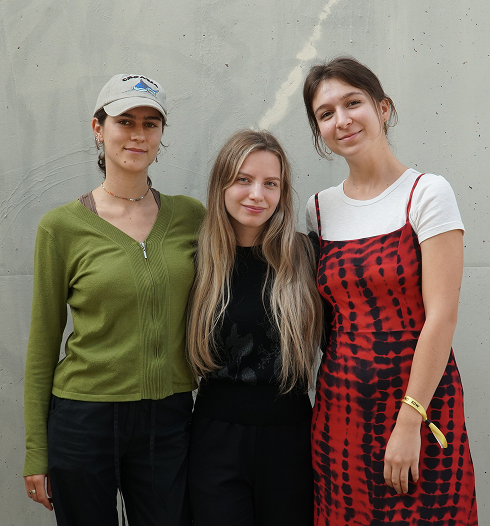
Design isn’t just about making; it’s about rethinking and shaping ideas that challenge the way we create and consume.
Lale studies Product Design at the University of the Arts Berlin, with a focus on sustainable design, biomaterials, and circular systems. Her work explores how materials can tell stories beyond their function, combining experimentation with clear, purposeful design. She is particularly interested in the dialogue between material, form, and process, and how design can emerge from within this interaction.
Through her experience at Mujo Lab, Lale deepened her fascination with material innovation and gained practical insight into material research and development. An Erasmus semester at the Estonian Academy of Arts further expanded her perspective on sustainability and design, strengthening her curiosity for experimental and forward-thinking approaches.

My designs are not just aesthetic solutions, they are a statement on how to look at things.
It all started with a love of detail in art lessons. So at the age of 14 Angelique decided to attend a school called ‘HTLBVLA Ortweinschule’, which specialises in interior design and wood technology. This school not only taught Angelique fundamental knowledge, but also showed her what is possible in the creative industry. To consolidate what I had learnt, I started an interior design course at the New Design University in St. Pölten. She also had the opportunity to complete an Erasmus+ semester abroad at the Academy of Fine Arts in Munich. Countless publications and project exhibitions followed over the years.

PROCESS
SKETCHES
“According to one estimate, around 5 million tons of tea waste per year are disposed of globally — mostly through landfilling or incineration.” (seneca, 2023)
1. Tea is brewed and served
2. The used tea leaves are gathered instead of discarded, becoming a valuable raw material.
3. The tea waste is turned into a new paper material
4. The material is shaped into lampshades and objects that naturally belong in the teahouse space
5. After use, the objects are composted, nourishing the soil. New tea plants can grow.
The global tea industry produced approximately 6.8 million tons in 2023. (FAO, 2023) Recycling even a portion of this amount could make a significant difference
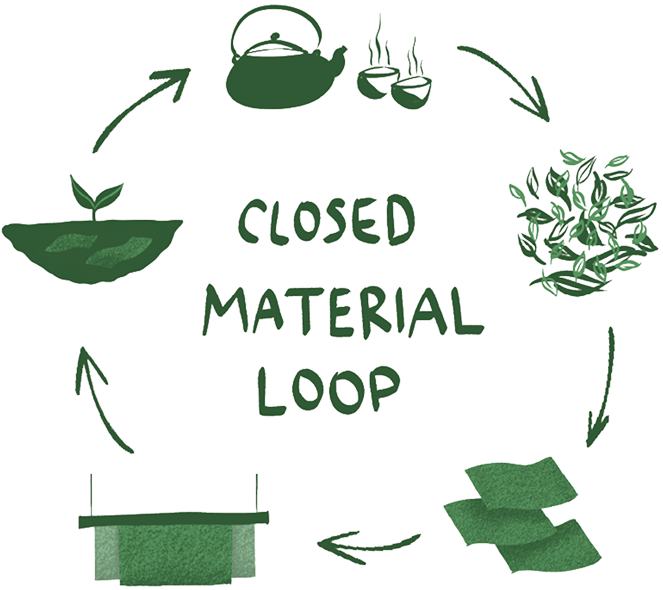
MATERIALS
The materials are made with the traditional papermaking technique. We were focusing on how we could use and incorporate all the residues of a teabag and its packaging. By using only mild household chemicals to soften up the tissues and fibers, we are able to create a blended paper that even holds the plastic and foils found in teabags and packaging.
This approach is highly sustainable because it reintegrates waste materials directly into a new production cycle without separating or discarding any components. Instead of creating additional waste streams, every element of the used teabag – from organic fibers to synthetic layers – becomes part of a continuous loop. The result is a material that not only reduces landfill waste and resource consumption but also demonstrates how everyday residues can be transformed into a functional, aesthetically unique product within a fully circular process.
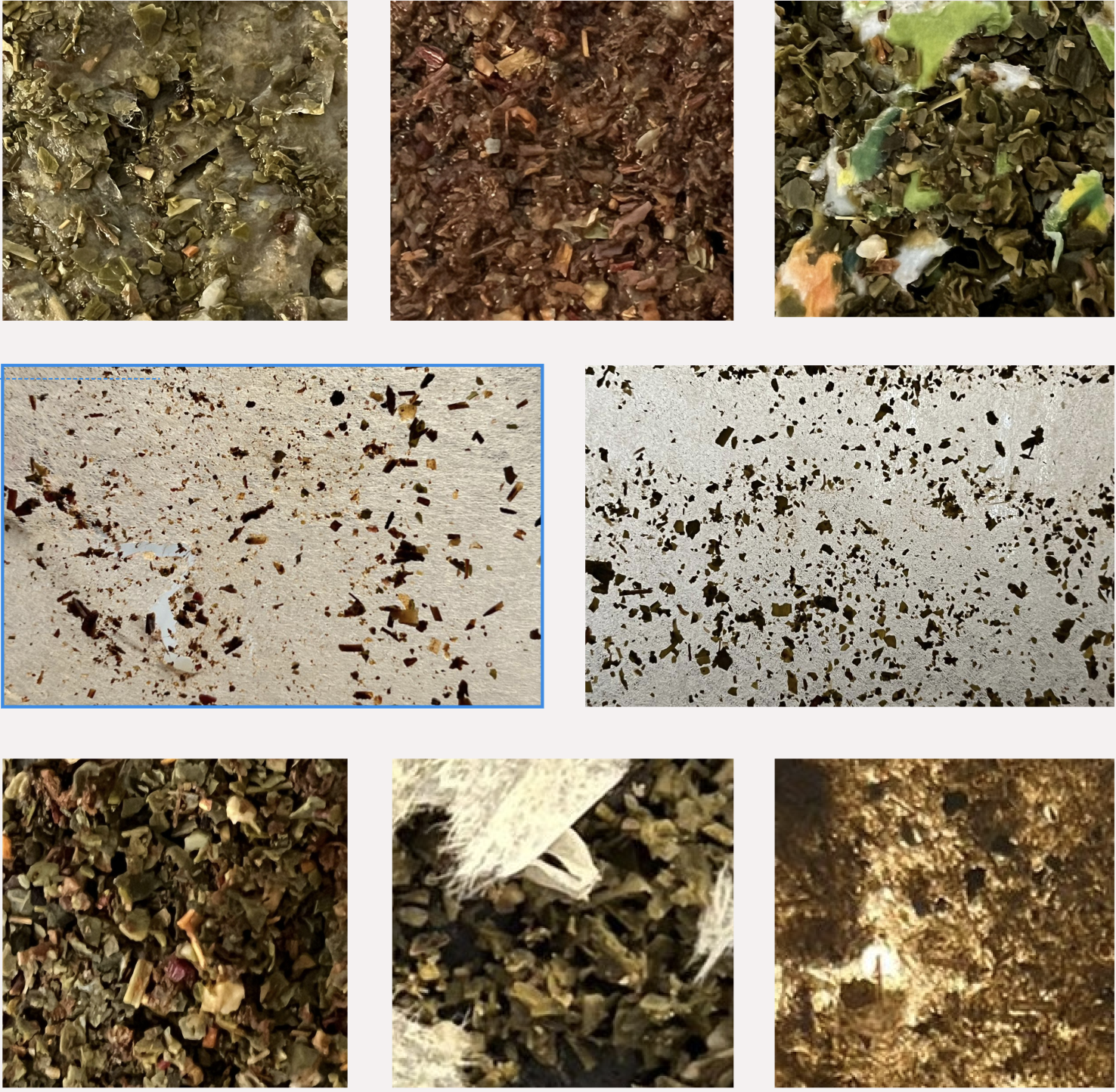
FINAL ARTWORK - LAMPSHADE SERIES
Instead of focusing on a single object, we developed an entire lampshade series that embodies the character of a tea house.
The series consists of two pendant lights and one floor lamp. Sleek, thin metal suspensions meet walnut wood, coming to life in combination with the materials we produced ourselves. It was important to us to emphasize both fragile and functional design. The translucent paper creates a warm, diffuse atmosphere, enhanced by two carefully positioned spotlight light sources that provide subtle highlights and depth. Depending on the color of the paper—whether inspired by fruit or herbal tea—the light can be adjusted to suit different moods. A deliberate design decision was also to overlap the paper layers, creating a sense of depth and richness in the overall composition.
The paper is carefully clamped between two wooden slats, ensuring stability while maintaining the delicate appearance. The thin metal rods pass through this layer and are guided by the deliberately slender canopy at the top, emphasizing the lightness and elegance of the overall design. This approach allows the structure to remain minimal yet functional, while the layered construction highlights both materiality and craftsmanship.

EXPERIENCE
On the first day, it was important for us to design an object that truly adds value. We agreed early on that it should be a small-scale piece. Initially, we focused more on exploring the material itself rather than the design concept. We took our time to settle on an idea that everyone liked. That morning, our ideas were quite different—CORK, for example, was one of them! The final concept, however, emerged naturally during our shared breakfast, when inspiration struck collectively.
It was important to keep everyone engaged with a strong idea and to find a good division of tasks. From that point on, we really started enjoying the process and focused extensively on the theme of “TEA.” We brainstormed different approaches together, discussing both function and form, which helped refine our direction. Everyone contributed their strengths, whether it was sketching, experimenting with materials, or organizing ideas. By exchanging feedback continuously, we could improve each prototype as we went along. The collaborative energy made the morning fly by, and before we knew it, our first tangible results were already taking shape. By this stage, the project felt alive, and our shared excitement motivated us to push ideas further
Everyone made use of their strengths, working to either digitize the approaches or bring them to life in physical models. By combining our individual skills, we were able to explore ideas more thoroughly and test different possibilities. With the help of other colleagues and their cameras, we were even able to take professional-quality photos of our models, for which we are very grateful. This approach allowed us to see what worked in practice and what needed refinement, keeping the process both productive and engaging

